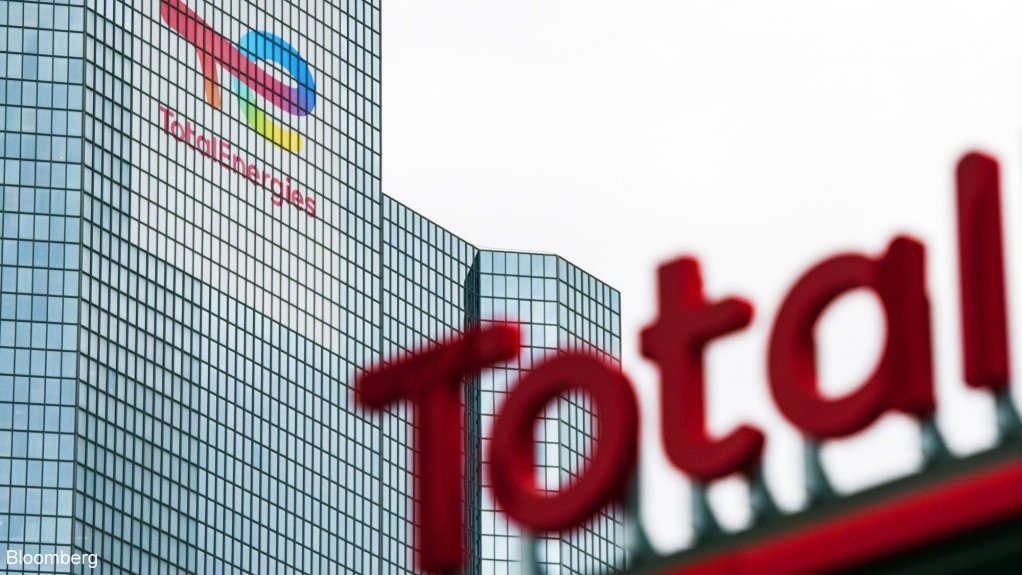In light of the world’s population being estimated to grow by at least 1.7-billion by 2050 and the fact that about 4.5-billion people already do not have sufficient access to energy, TotalEnergies outlines in its latest Energy Outlook a new scenario that reflects the current trajectory of various countries up to 2030.
This scenario, which includes Total’s anticipated technological development and public policies globally, enables the company to present the expected evolution of the energy system in future, in line with current trends and the efforts still required to achieve the objectives of the Paris Agreement.
Total’s “trends” scenario yields a 2.6 ˚C temperature increase by 2100, above the target agreed in the Paris Agreement, while the “momentum” scenario assumes that countries reach their carbon neutrality targets by 2050 and yields a 2.3 ˚C temperature increase by 2100.
The “rupture” scenario proposes a path to remain well below the Paris Agreement target of global warming at 1.8 ˚C, which, to achieve that objective, requires rapid deployment of decarbonisation technologies and advanced economies supporting the Global South’s energy transition.
For the ideal scenario to realise, Total says priority should be given to facilitating global substitution of fossil fuels in every country to renewable energy and flexible gas and accelerating the reduction of methane emissions from fossil fuel production.
This will require policymakers to focus on allocating subsidies and setting mandates following the cost and technology merit curve, to minimise costs to citizens and eliminating bottlenecks in developing supporting infrastructure, particularly electricity grids and accelerating connection to this infrastructure.
Policymakers will also have to cooperate more internationally to deploy the cheapest available technologies and develop financial instruments in developing countries.
“Ensuring sufficient access to energy for the world's entire population today requires tripling the energy available in the least developed countries. Taking into account their expected population growth, by 2050 they will need four times more energy than today,” Total states.
The collective challenge is, therefore, to reduce greenhouse-gas (GHG) emissions while responding to the legitimate demand for more energy for the population of emerging countries.
Since 2000, the world have experienced a decoupling between GDP growth and energy demand growth. Electricity has grown faster than the other energies, and renewables have accelerated their growth since 2015.
However, demand for coal, which is often domestic and inexpensive, continues to grow, and energy intensity gains – at 1.4% a year over 2000 to 2022 – remain below the ambition set at COP28 – 3% to 4% a year.
Analysis by geographical zone shows that rising living standards, particularly in India and China, are the main drivers of the increase in energy demand in recent years.
Two major developments occurred in the last 20 years that will shape the energy transition: the shale gas and oil revolution in the US has transformed the energy landscape in the US and around the world; and a few low-carbon technologies, in particular solar panels and electric vehicles (EVs), have made sufficient progress to be deployed on a large scale and be cost-competitive for consumers, provided that, at the same time, electricity networks receive sufficient investment.
IN DETAIL
Total’s trends scenario reflects the current trajectory of the various countries up to 2030 and incorporates its anticipation of future technological and public policy developments in line with current trends. It accounts for the recent acceleration in the penetration of mature decarbonization technologies: solar and wind power to produce electricity, EVs and heat pumps to use it, particularly in China.
However, infrastructure constraints (in particular electricity grids) and geopolitical tensions are limiting their large-scale deployment.
The momentum scenario, in turn, is a forward-looking approach integrating the decarbonisation strategies of countries that have committed to net carbon neutrality by 2050 (NZ50 countries), as well as the Nationally Determined Contributions of other countries.
It implies the electrification of final demand in NZ50 countries and China, phasing-out coal in NZ50 countries, a sharp reduction in China and only slight growth in this energy source in the Global South countries, the use of natural gas as a transitional energy source for electricity and industry in all countries, and the deployment of new energies in non-electrifiable sectors such as decarbonised hydrogen in industry and transport, and sustainable fuels in aviation and marine in NZ50 countries and China.
In this scenario, fossil fuels still cover half of the growth in energy demand in the Global South, owing to insufficient low-carbon investment.
Total’s rupture scenario is a normative scenario designed to achieve a temperature increase of less than 2 °C by 2100. For example, moving from trends to rupture requires an 80% increase in installed solar and wind power capacity in India and the Global South by 2030.
Beyond 2040, all decarbonisation levers are applied globally, in particular the deployment of new energies and carbon capture and storage. In this scenario, decarbonised technologies are deployed globally according to their merit curve.
To move from trends to rupture, the world should collectively give priority to existing technologies offering an acceptable abatement cost. In particular, public decisionmakers should step up international cooperation to ensure that the cheapest technologies are available globally, and that financial instruments adapted to developing countries are deployed.
"To keep pace with the growth in energy demand which is essential to the legitimate improvement in the standard of living of the emerging countries’ population while simultaneously reducing GHG emissions, public policies and the players in the energy chain must give priority to mature and sufficiently affordable low-carbon technologies and cooperate to deploy them across the globe.
“This is the way to combine economic and social development with the acceleration of the energy transition,” concludes Total strategy and sustainability director Aurélien Hamelle.
Edited by: Chanel de Bruyn
Creamer Media Senior Deputy Editor Online
EMAIL THIS ARTICLE SAVE THIS ARTICLE
ARTICLE ENQUIRY
To subscribe email subscriptions@creamermedia.co.za or click here
To advertise email advertising@creamermedia.co.za or click here













